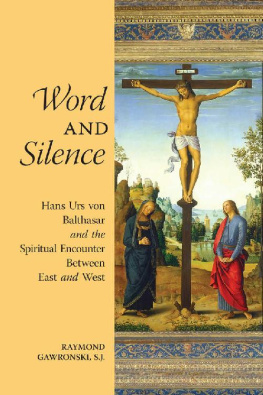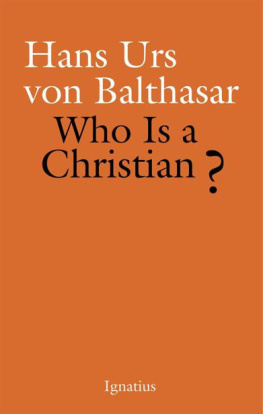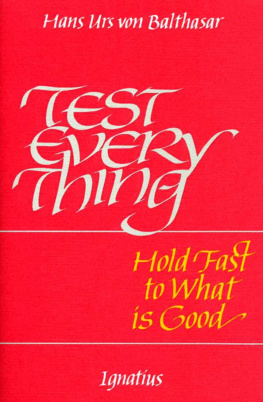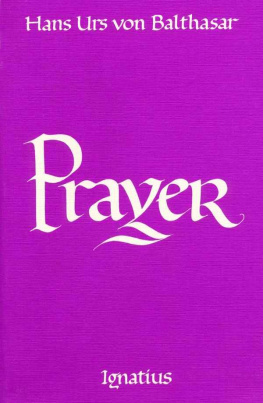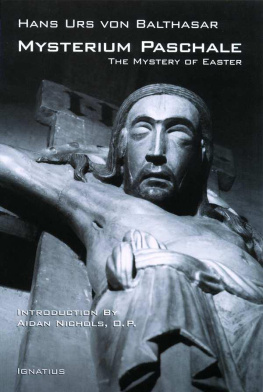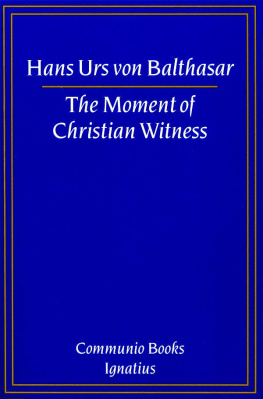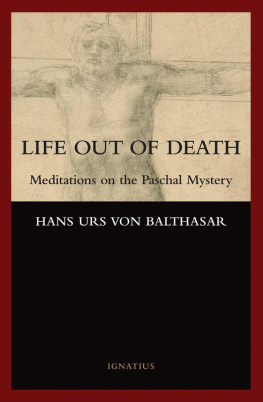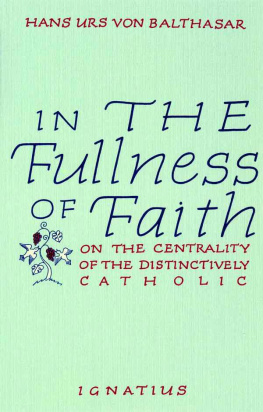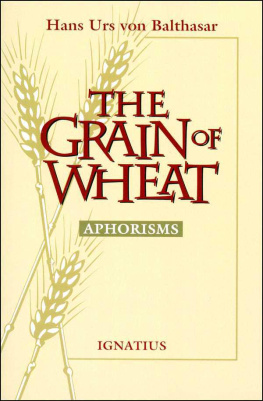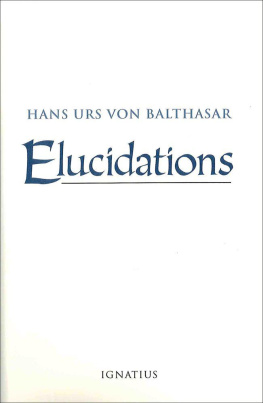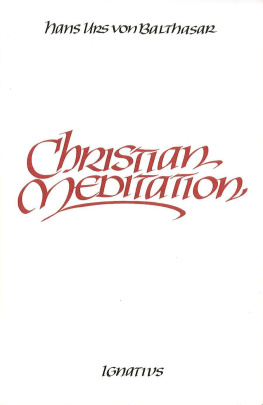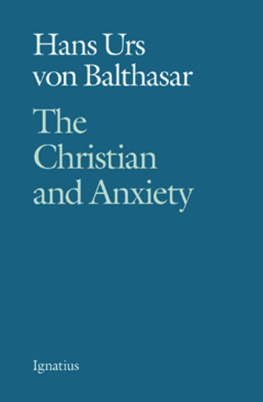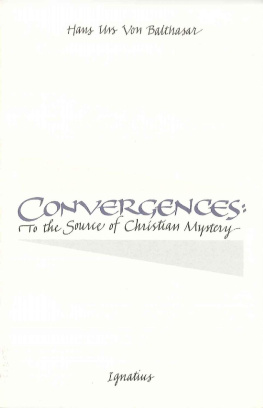word and silence
Fr. Raymond Gawronski, SJ
WORD AND SILENCE
Hans Urs von Balthasar
and the
Spiritual Encounter
between
East and West


First published 1995 by T&T Clark, Ltd.
Second edition published in 2011 by Vianney Press
Third edition published by Second Spring,
an imprint of Angelico Press, 2015
Copyright T&T Clark, Ltd., 1995
Copyright Angelico Press, 2015
All rights reserved
No part of this book may be reproduced or transmitted,
in any form or by any means, without permission.
For information, address:
Angelico Press
4709 Briar Knoll Dr.
Kettering, OH 45429
angelicopress.com
ISBN 978-1-62138-110-5 paperback
ISBN 978-1-62138-111-2 cloth
ISBN 978-1-62138-112-9 ebook
Cover image credit: Crucifixion with Mary and
Saint John the Evangelist, and Saint Mary Magdalene
(detail), between 1482 and 1485. Attributed to
Pietro Perugino (14481523)
(formerly attributed to Raphael [ 1483 1520 ])
Cover design: Michael Schrauzer

To the loving memory
of my father
Stanley Gawronski,
who by his counsel and his life
taught me to love learning
CONTENTS
List of Abbreviations
Hans Urs von Balthasar
(All translations into English of the work of
Hans Urs von Balthasar used in this work are original)
| BG | Das Betrachtende Gebet |
| CM | Christlich Meditieren |
| CS | Christlicher Stand |
| CSEF | Christen Sind Einfltig |
| CUDW | Das Christentum und die Weltreligionen |
| DBDG | Des Bordes du Gange aux Rives du Jourdain |
| DGAT | Die Grossen Arcana des Tarot |
| EBAA | Erster Blick auf Adrienne von Speyr |
| EPIL | Epilog |
| GIMF | Das Ganze im Fragment |
| GINL | Glaubhaft ist nur Liebe |
| HFSK | Herrlichkeit. Band II. Fcher der Stile. Teil 1: Klerikale Stile |
| HFSL | Herrlichkeit. Band II. Fcher der Stile. Teil 2: Laikale Stile |
| HRMA | Herrlichkeit. Band III, 1. Im Raum der Metaphysik. Teil 1: Altertum |
| HRMN | Herrlichkeit. Band III, 1. Im Raum der Metaphysik. Teil 2: Neuzeit |
| HSG | Herrlichkeit. Eine theologische sthetik. Band I. Schau der Gestalt |
| HTAB | Herrlichkeit. Band III, 2. Theologie. Teil 1: Alter Bund |
| HTNB | Herrlichkeit. Band III, 2. Theologie. Teil 2: Neuer Bund |
| KLAR | Klarstellungen |
| LRLG | La Realt e la Gloria |
| MAHE | Marie Heute Ehren |
| MFHE | Maria fr Heute |
| MWDB | Mein Werk. Durchblicke |
| NK | Neue Klarstellungen |
| S1 | Verbum Caro. Skizzen zur Theologie I |
| S2 | Sponsa Verbi. Skizzen zur Theologie II |
| S3 | Spiritus Creator. Skizzen zur Theologie III |
| S4 | Pneuma und Institution. Skizzen zur Theologie IV |
| S5 | Homo Creatus Est. Skizzen zur Theologie V |
| SIMG | Schwestern im Geist |
| TDES | Theodramatik. Vierter Band: Das Endspiel |
| TDHA | Theodramatik. Dritter Band: Die Handlung |
| TDPC | Theodramatik. Zweiter Band: Die Personen des Spiels. Teil 2: Die Personen in Christus |
| TDPM | Theodramatik. Zweiter Band: Die Personen des Spiels. Teil 1: Der Mensch in Gott |
| TDPR | Theodramatik. Erster Band: Prolegomena |
| THGE | Theologie der Geschichte |
| TLGW | Theologik. Dritter Band: Der Geist der Wahrheit |
| TLWG | Theologik. Zweiter Band: Wahrheit Gottes |
| TLWW | Theologik. Erster Band: Wahrheit der Welt |
| UA | Unser Auftrag |
| WIEC | Warum ich ein Christ bin |
| WISY | Die Wahrheit ist symphonisch |
Preface to the First Edition
T he written work of Hans Urs von Balthasar is encyclopedic both in scope and in volume. Perhaps more than of any other writer in this century can it truly be said of him that he wrote more in his lifetime than most people ever read. Thus any study of his work cannot readily claim to be exhaustive. This study certainly does not make that claim.
Rather, it is the ambition of this work to present an overview of the thought of von Balthasar as it regards the theme of Word and Silence. In setting his point of view against the background of some aspects of world religions and some of the philosophies of Europe, it is necessary of course to present some of his understanding of these systems of thought. But as the point of the work is to present Balthasars own understanding, this book does not attempt to go back to the original texts of the religions themselves, nor does it ambition a study of the many thinkers whofrom St. Anselm to Przywara and Guardini, from St. Gregory of Nyssa to Nietzsche and Heidegger to name but a fewwere significant for Balthasar. Some few thinkers are mentioned in our work; far more are left untouched. Further research into the roots of Balthasars thought must be made, one which will be able to take into greater account other secondary literature as well, and it will greatly enrich the theme we are investigating. Given the limits of one already ambitious book, such was unfortunately impossible here.
This book took shape during years of search for an articulation of the Catholic Faith which would let the Beloved Face (bruised and covered with thorns as Balthasar might say) show in a world looking elsewhere for meaning, one which would attune the ear for that Voice which once heard leaves one forever listening (lauschend).
There are many to whom I owe profound gratitude, more than I can here mention. But I must call to mind some who stand out as guides on this journey.
First of all, then, I am profoundly indebted to Huston and Kendra Smith, teachers, models, friends who opened my mind and heart to the wide world I had heard and read of in my home. Without their encouragement and example, I would not have ventured into many worlds, academics among them, and my respect for ways other than the Catholic would likely not have blossomed. They are joined by Phil Novak in love of Asia and her wisdom.
This book could not have been written without the wisdom, intellectual awareness and kindness of Fr. John ODonnell, S.J. of the Gregorian University. Fr. Rino Fisichella of that University was most generous in supplying helpful suggestions.
The Society of Jesus is the mother who has encouraged me and supported me in many years of study, and I am mindful that without the support of my superiors and brothers in the Society, this study would not have been possible. I owe especial gratitude to the Maryland Province which has kept a venerable tradition of Jesuit scholarship alive. Of note is Fr. Thomas King of Georgetown University whose commitment to the Logos refused to let me long abandon discursive reason for quieter realms. It was Fr. Leo ODonovans generous suggestion that led me to write on von Balthasar.
Next page
